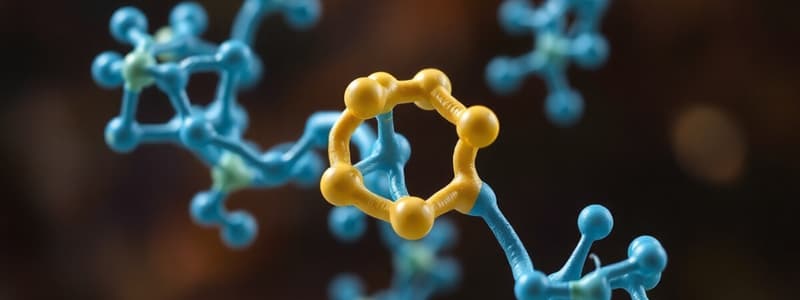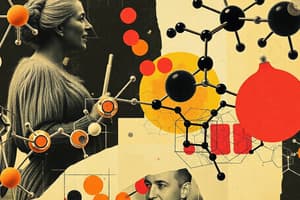Podcast
Questions and Answers
What is the primary advantage of electron microscopy compared to light microscopy?
What is the primary advantage of electron microscopy compared to light microscopy?
- It can visualize live specimens.
- It utilizes longer wavelengths of light.
- It requires fewer staining procedures.
- It provides higher resolution due to shorter wavelengths. (correct)
Which microscopy technique uses phase shifts in illuminating light to enhance contrast?
Which microscopy technique uses phase shifts in illuminating light to enhance contrast?
- Fluorescence
- Darkfield
- Phase contrast (correct)
- Brightfield
What is the primary reason cells are small?
What is the primary reason cells are small?
- To decrease metabolic activity
- To minimize energy consumption
- To maintain structural support
- To allow adequate exchange of materials (correct)
What cellular structure is not found in prokaryotes?
What cellular structure is not found in prokaryotes?
Which of the following macromolecules is correctly paired with its building block?
Which of the following macromolecules is correctly paired with its building block?
In which microscopy technique are thin sections of specimens used to create high-detail 2D images?
In which microscopy technique are thin sections of specimens used to create high-detail 2D images?
Which type of microscopy allows for the visualization of specific cellular components by utilizing fluorophores?
Which type of microscopy allows for the visualization of specific cellular components by utilizing fluorophores?
During which process are monomers linked together to form polymers?
During which process are monomers linked together to form polymers?
Which level of protein structure involves the folding of a polypeptide into a 3D structure?
Which level of protein structure involves the folding of a polypeptide into a 3D structure?
What characterizes the organization of DNA in eukaryotic cells?
What characterizes the organization of DNA in eukaryotic cells?
What is the role of enzymes in the context of macromolecule synthesis?
What is the role of enzymes in the context of macromolecule synthesis?
In what aspect do prokaryotes and eukaryotes share similarities?
In what aspect do prokaryotes and eukaryotes share similarities?
Which cell theory principle states that cells arise only from existing cells?
Which cell theory principle states that cells arise only from existing cells?
Which microscopy technique uses an angle to illuminate samples, avoiding direct light on the objective lenses?
Which microscopy technique uses an angle to illuminate samples, avoiding direct light on the objective lenses?
Which microscopy technique uses lighting from the top to observe larger cells?
Which microscopy technique uses lighting from the top to observe larger cells?
Which type of bond links amino acids to form proteins?
Which type of bond links amino acids to form proteins?
Study Notes
The Molecules of Life
- Water is the solvent of life, able to dissolve more molecules than any other solvent.
- Water is a polar molecule, meaning it has a positive and negative end, enabling it to dissolve other polar molecules and charged molecules.
- Macromolecules are large polymers made up of smaller repeating subunits called monomers.
- Carbohydrates are polymers of sugars, with glucose being a key example.
- Lipids are not polymers but hydrophobic molecules, including fats and oils.
- Proteins are polymers of amino acids. The specific sequence and properties of amino acids determine the protein's structure and function.
- Nucleic acids are polymers of nucleotides, with DNA and RNA being prime examples.
- Polymerization is the process of linking monomers together, facilitated by dehydration synthesis, which removes a water molecule.
- Depolymerization breaks apart polymers into monomers through hydrolysis, which adds a water molecule.
- Enzymes are biological catalysts that speed up the rates of both polymerization and depolymerization reactions.
Protein Structure
- Primary structure refers to the linear sequence of amino acids in a polypeptide chain.
- Secondary structure arises from hydrogen bonding between amino acids, leading to formations like alpha-helices and beta-sheets.
- Tertiary structure is the three-dimensional folding of the polypeptide chain, determined by the interactions and properties of the amino acid side chains.
- Quaternary structure involves the assembly of multiple polypeptide chains (subunits) into a larger, functional protein complex.
- Amino acids contain nitrogen and are slightly acidic.
- R-groups or side chains are unique for each amino acid, defining the chemical properties and interactions of proteins.
- Peptide bonds are covalent bonds linking amino acids in a protein chain.
Cell Theory
- All organisms are composed of one or more cells.
- The cell is the fundamental structural and functional unit of life.
- Cells arise only from the division of pre-existing cells.
Reasons for Cell Size Limits
- Cells need a sufficient surface area to allow efficient exchange of materials with their surroundings.
- As cell volume increases, a proportionally larger surface area is needed for adequate exchange.
- Larger volumes require more structural support to maintain shape and integrity.
- Cells with high surface-area requirements often develop convoluted or branched surface membranes.
- Cells with larger volumes have evolved cell walls to provide structural support.
Microscopy
- Resolution is the ability of a microscope to distinguish two objects as separate entities.
- Magnification increases resolution.
- Contrast enhances details within a specimen, but it cannot increase resolution.
Light Microscopy
- Reflected Light: Used in stereo microscopes (dissecting microscopes), light shines from the top. Best for larger specimens.
- Transmitted Light: Used in stereoscopes (some can use light from the bottom) and compound microscopes.
- Brightfield: Basic microscope, often requiring staining to visualize details.
- Darkfield: Illuminates the sample at an angle, so light does not directly hit the objective lenses, giving a bright specimen against a dark background.
- Phase contrast: Creates phase shifts in the light, revealing details based on differences in refractive index.
- Differential Interference Contrast (DIC): Creates a pseudo-3D image by splitting the light beam and recombining it after passing through the specimen.
- Fluorescence: Uses fluorophores to visualize specific structures by emitting light after absorbing excitation light. Good for imaging live specimens and specific cellular components.
- The process involves absorbing a photon, exciting an electron to a higher energy state, and then releasing a photon of longer wavelength when the electron returns to its ground state.
Electron Microscopy (EM)
- Provides high resolution due to the shorter wavelengths of electrons.
- Specimens are stained with heavy metals that electrons cannot pass through.
- Transmission Electron Microscopy (TEM): Images thin sections of specimens, creating detailed 2D images.
- Scanning Electron Microscopy (SEM): Visualizes 3D surface contours of specimens at lower magnifications.
Prokaryotes vs. Eukaryotes
| Feature | Prokaryotes | Eukaryotes |
|---|---|---|
| Examples | Bacteria, Archaea | Animals, Plants, Fungi |
| DNA | Found in the nucleoid | Housed in the nucleus |
| Organization | Single, circular chromosome and often plasmids | One or more linear chromosomes |
| Basic Differences | Usually unicellular, some multicellular | Usually multicellular |
| Small (1-3 micrometers) | Small to very large | |
| No membrane-bound organelles | Membrane-bound organelles | |
| Nucleoid | Nucleus | |
| Single circular chromosome and plasmids | Linear DNA chromosomes | |
| Similarities | Plasma membrane, cytoplasm, ribosomes, cytoskeleton | Plasma membrane, cytoplasm, ribosomes, cytoskeleton |
Studying That Suits You
Use AI to generate personalized quizzes and flashcards to suit your learning preferences.
Related Documents
Description
Explore the fundamental molecules that constitute life in this quiz. Covering essential topics such as water, macromolecules, and the processes of polymerization and depolymerization, this quiz will test your understanding of biological chemistry concepts. Perfect for students studying biology or related sciences.




